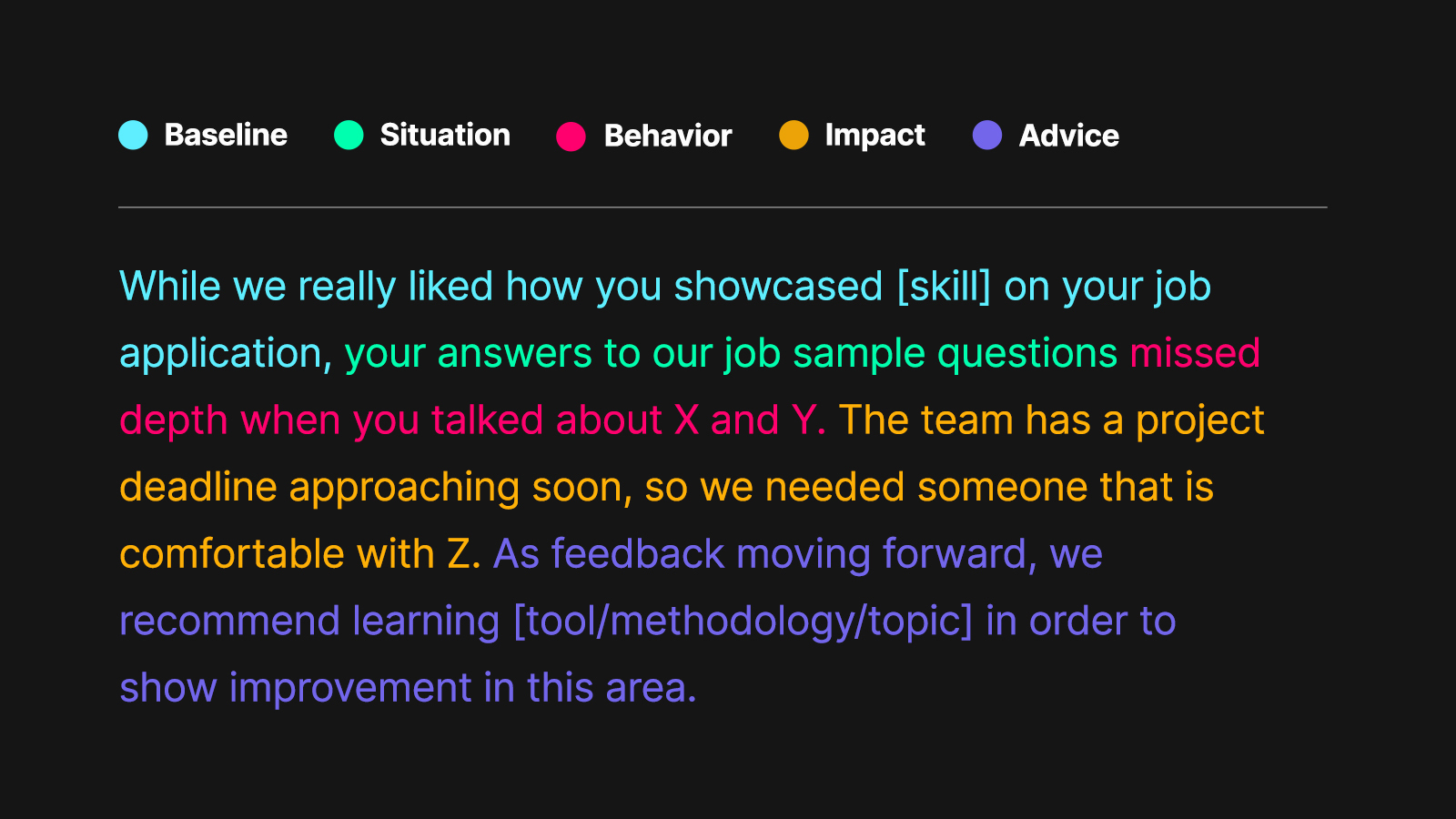How to give useful feedback when rejecting candidates

One of the hardest parts about hiring is having to reject candidates. It’s not nice and there’s no elegant way to do it. There are, however, ways of doing it that are much better than others, and that’s by providing actionable, effective candidate feedback for people to improve their future applications with.
But where do you even start? At what point do you give feedback, and how should it be structured? We know these are tough questions, so we’ve outlined what candidate feedback should achieve and provided a sample template you can use at the end in your own recruitment process.
Why feedback from companies is important
1. Candidate experience & personal development:
One of the big reasons that job hunting frustrates candidates is because it can feel like you’re sending each application out into the void, with no measure of whether you’re getting things right or wrong. Personalized feedback breaks this cycle and makes the candidate experience much, much better.
2. Pipeline & database building:
Recruitment should be the most well-planned project in any company — the right people will make or break you.
Therefore, companies need to start seeing recruitment drives as long-term projects instead of something that’s quick and temporary. And feedback plays a big role here. As you provide advice to rejected applicants, you’ll be building a network of motivated job hunters whose development you’ve actively supported.
This will save you time and money by allowing you to fill future vacancies, faster.
3. Company reputation:
Entry-level candidates today are the unicorns of tomorrow, and their decision to join a company won't depend exclusively on salaries — especially in gaming where the competition is stiff.
Even though the industry seems big, it's also small when it comes to how information spreads. Poor application processes, unsafe work environments, and senior management's lack of accountability are regular speaking points in the games industry, so bear this in mind during your recruitment cycles.
When should companies give feedback?
The major question when it comes to feedback: at what stage should you provide it? Historically, when advice has been provided, it’s usually been from the interview round onwards.
This leaves countless people in the dark as to why they were rejected, though, which we don’t think is right.
When we polled a number of HR staff, department leads, and senior managers in the games industry as part of our candidate report, the consensus was that the initial application stage doesn’t demand any feedback at all to candidates since they’ve yet to be interviewed by the company.
And while it's understandable that providing feedback can be overwhelming for smaller HR departments, it should still be possible to make some indication to candidates of why they didn’t progress.
Of course, the depth of feedback will vary depending on the stage candidates manage to reach; the further along they make it, the more feedback they’re entitled to. However, that first bit of advice when you’re struggling to break into a field is the most crucial, especially for individuals currently underrepresented in the industry, as it can answer the question of why their applications aren’t being successful.
Therefore, our answer is:
Touch-points should happen after each and every stage of the recruitment process, whether the candidate is progressing or not. This especially applies if the process is running for longer than expected.
How should you structure your feedback? (Template)
Since the goal of candidate feedback is to motivate people and show them where they can improve, it's important to structure yours in a way that a) doesn’t sound judgemental and b) doesn’t put candidates down. And while we can’t tell you exactly what to write, we can give you a standardized template to follow.
A great methodology to follow when providing candidate feedback is the Situation-Behavior-Impact tool developed by the Center for Creative Leadership.
Here’s how it works:
- Situation: Provide clear context by outlining the situation the feedback is referring to, giving the candidate a specific reference point to take into consideration.
- Behavior: Describe the behaviour that didn't reach the hiring team's expectations. Be very mindful to not make assumptions on the reason why the candidate fell short.
- Impact: Then highlight how that behaviour would affect your team or organization, justifying why you decided not to move forward in this case.
- Advice: Specify what the candidate should do to reach the required level for the role. It's fundamental that the advice is actionable and preferably suggests a course of action for them to take.
Additionally, we recommend including this too:
- Baseline: Wherever possible, highlight what the candidate did right to establish a positive baseline. This helps separate what you thought worked well in their application and what didn’t. Laura Maz explained it well by saying:
"Without a baseline, it feels like a call to start from scratch, which isn't always needed. It can be tough to act on feedback when you're under the impression that everything you've done up to this point should be discarded.”
With all of that in mind, here's an example:

Taking a structured approach like this, where real thought has gone into how your feedback can support the candidate in future applications, is ultimately the best way to reject someone. Implement it in your future hiring rounds and you’ll be providing a best-in-class candidate experience — even to the people you can’t bring through the whole process.
Even with this information behind you, we know it’s not always easy to turn advice into action. That’s why we offer our services to companies in the video game industry looking to improve their hiring process and #RethinkRecruitment. If you’d like to learn more, get in touch with us to book an intro call.